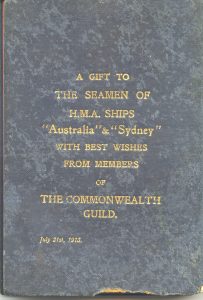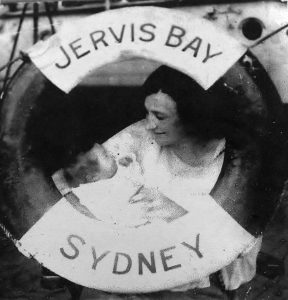- Author
- Editorial Staff
- Subjects
- Biographies and personal histories
- Tags
-
- RAN Ships
- HMAS Australia I
- Publication
- June 2017 edition of the Naval Historical Review (all rights reserved)
Recently one of our members and cherished chaplains, the Reverend Dr Gareth Clayton, presented the Society with a copy of the Gospel of St John which had been given into his safekeeping at a memorial service. The back cover of this pocket edition has the following message embossed in gold lettering:
A gift to the seamen of HMA Ships Australia & Sydney with best wishes from members of the Commonwealth Guild. July 21st 1913.
Inside the flyleaf is inscribed in pen: Donald McKenzie, HMAS Australia, St Vincent, Cape Verde Islands. August 2nd 1913.

Back cover of Gospel of St John presented to Leading Telegraphist Donald McKenzie
So what is the story behind this small memento, now more than a century old? The first clue might be that this Gospel was published by a Roman Catholic seminary in England. This is interesting as Catholic priests had only recently been invited to minister to the RAN. When HMAS Australia commissioned she had two chaplains, the hard working Anglican Frederick Riley and the charismatic Catholic Patrick Gibbons, the RAN’s first Catholic priest. Did Gibbons prevail upon his superiors to furnish some keepsakes which could then be provided to his flock on some suitable occasion?
When commissioned as a flagship under Rear Admiral Sir George Patey Australia had a complement of 850 men. Far more than the fledgling navy could muster and as a result more than half, and nearly all senior positions, were held by Royal Naval personnel.
Donald McKenzie was born at Broken Hill on 18 February 1894 and entered the RAN as an Ordinary Telegraphist posted to HMAS Yarra on 01 July 1911. The torpedo-boat destroyer had only recently arrived after her delivery voyage from her English builder’s yard and was not commissioned into the Commonwealth Naval Forces until 01 March 1911. This made young Donald one of the first entrants into the newly created Royal Australian Navy.
He served in Yarra for one year, was two weeks at Flinders Naval Depot, and then on his way to England for further training and to standby as part of the initial complement of the battle cruiser Australia, building at John Brown’sYard on the Clyde. At the commissioning of the flagship in Portsmouth on 21 June 1913, Donald is rated as a Leading Telegraphist, when only 19 years of age. A month later Australia sailed from Portsmouth for the Cape Verde Islands where she took on 2,000 tons of coal, before proceeding to the Cape to meet up with HMAS Sydney which had departed England earlier. The two ships then proceeded in company before meeting up with the remainder of the Fleet at Jervis Bay. This gave time to spruce up before the excitement and grand spectacle when Australia led the Fleet intoSydney Harbour on 4 October 1913.
Still in Australia in April 1915, Donald is promoted Petty Officer and, when only 24 years of age in March 1918, he achieves the accolade of becoming a Warrant Telegraphist. He next receives promotion to Mate and on 01 July 1922 and is posted on loan to the Royal Navy for further training.
On 22 November 1922 Donald and his wife Ellen took passage from Sydney to England in TSS Jervis Bay (later to win fame as an Armed Merchant Cruiser) which was then on her maiden voyage. Ellen is pregnant but thought she could safely make the passage and, in any case, the ship had a good doctor. Baby Jean was, however, impatient and entered this world on 1 December when crossing the Great Australian Bight, with Donald stepping ashore two days later in Adelaide to register the birth – officially she was born ‘At Sea’. On reaching Fremantle the baby was baptised Jean Jervis (after the ship) McKenzie.

A year later a younger brother Donal (sic) Bruce was born during their two years exchange posting. Donald was now a Lieutenant when the family returned home in 1925, again using their good luck ship Jervis Bay.
Now nearing his prime, in 1933 Donald was promoted Lieutenant Commander – at this time great progress for a humble Ordinary Seaman. Here the story is related by daughter Jean (1).
Dadwas an amateur inventor known as an ideas man. A colleague was Paymaster Commander Eric Kingsford-Smith, brother of the famous [Sir] Charles Kingsford-Smith, pilot of the Southern Cross. And he was about to do a trip to New Zealand, so his brother rang my father and said, Charles is going on a trip over to New Zealand. He wants to know if you can think of some way he can drop something from the plane which will float on the water, in order to take their bearings or something like that. The words I recall from the age of ten were to assess the drift, whatever that is.
He always liked to include me in interesting happenings and so he thought for a while and he said: ‘If you get those very thin bottles that chemists use, scientists and so forth for experiments, and fill those with aluminum powder, drop them from the plane, they should break on impact and leave a patch on the water and you should be able to get a bearing from that’.
So we went out on the Sunday afternoon and I helped them fill the bottles and then eventually we boarded the plane and went off round to sea and all around Sydney Harbour, which was fascinating because I had never been in a plane before and I had never seen Sydney Harbour from up there! And anyhow, I don’t know what went on in the front of the plane because I was in one of the only about two seats in the back anyway. Weren’t even fixed to the floor, you know.
So I was fascinated because I found I could open the window and put my hand out to feel the force of the wind, which was really quite interesting. Anyway, they came back and landed after about half an hour and I found that the idea hadn’t been successful because the glass didn’t break in the flasks. So my father’s next idea was: ‘Well you will just have to get some of those little brown paper bags and put some of the aluminum powder in those, a few pieces of metal so that they will drop, and that should work’.And as far as I know that’s the way they navigated over to New Zealand the following day.
But something else happened at this time as Donald suddenly resigned his commission and on 17 January 1934 he was transferred to the Emergency List. Was this associated with the untimely death (by suicide) of a close friend and fellow Communicator, LCDR Alan Dermot Casey? McKenzie being eight years older than Casey and with much greater experience was possibly a mentor to the young signals officer.
Casey, a 1916 entry to the Naval College, was compulsorily retired from the navy, having suffered nervous breakdowns which were not symphatically understood by naval authorities. The Casey family took court action against the Naval Board with Donald on their side. Newspaper reports of the time saying retired LCDR McKenzie disagreed with statements made by the influential Minister for Defence, Senator [Sir] George Pearce. Donald strongly advocated a Royal Commission into the circumstances surrounding Casey’s death. Bowing to public pressure a Royal Commission was eventually held. However its findings must have been a great blow to the litigants as the Commission found that the retirement of LCDR Casey was necessary in the interests of the Service and that there was no impropriety associated with it.
Daughter Jean followed in her father’s footsteps and joined the Women’s Royal Naval Service on 1 October 1942. Her official number WR-87 indicates she was the 87th woman to join the service. Naturally she became a Telegraphist and served until the end of the war being discharged ashore in July 1945. From newspapers of these times we find that on 18 January 1946 Jean married Lieutenant Theo Nysen of the Royal Netherlands Navy with her brother Sub Lieutenant Donal McKenzie, RANR being best man. Another clue falls into place regarding the Gospel, as this is the first occasion in the family Service Records that religion is mentioned, and we find young Donal Bruce is a Catholic. Donal was discharged ashore on demobilization in February 1946.
With Donald (senior’s) considerable watch-keeping experience he applied for, and was granted, a Board of Trade Master’s Certificate. In the darkest days of the Great Depression did he then obtain precarious employment in the Merchant Service?
Donald briefly returned to the navy and rejoined for temporary active service in August 1941. But this does not appear to have been too successful as his appointment was terminated in July 1943. What happened next is unknown as there is an entry showing him transferred to the Retired List at the time of his sixtieth birthday on 18 February 1954.
We should be interested in hearing from any reader who has more information on the later career of the colourful LCDR Donald McKenzie.
Perhaps we should take our parting words from the Gospel: These things I have spoken to you, that my joy may be in you, and your joy may be filled.
Gospel of St John Chapter XV Verse 11
Notes:
An edited version taken from the story of Jean (Nysen) McKenzie, Billycan Press, 12 June 2014.




